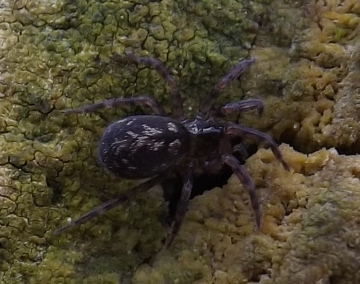Summary for Tegenaria gigantea
|
National Distribution
Terms of Use. Double-click on map to go to region

Explore Regional Distribution
Identification guidance for Tegenaria gigantea
Please log on and add a note on this species
About this species
Recorded altitude range
Species text
Nomenclature
Bolzern et al. (2013) proposed that Tegenaria atrica, T. saeva and T. gigantea (= T. duellica) should be placed (together with T. agrestis and T. picta amongst British spiders) in a new genus, Eratigena. They further proposed that E. atrica, E. saeva and E. duellica represented just one species, E. atrica. While the transfer to a new genus is justified, the collapse of the three species into one is definitely not (see Oxford & Bolzern 2018 for details).
Distribution
E. duellica is widespread across eastern, central and northern England, but more sporadic in Scotland and the west. In mainland Europe, the natural range seems to be confined to France and the Iberian Peninsula although it has been reported in a number of other countries (https://araneae.nmbe.ch/data/264), apparently as a result of accidental importation by humans. It is well-established in the Pacific North-west of North America.
Habitat and ecology
The species is often found in houses, garages and sheds. It also occurs in areas far from human habitation throughout its British range, where it inhabits rock, stone and tree crevices, overhanging banks, rabbit holes and very dense vegetation. Within houses, the species is most often noticed in late summer and autumn when males wander freely in search of the more sedentary females. Mating occurs in autumn and females over-winter with stored sperm. In spring, with increasing temperature and food supply, egg-sacs are produced over an extended period. Both sexes overwinter as half-grown juveniles and mature the following year. Males die after mating (lifespan some 18 months) but females may live for a further year (lifespan two and a half years or more). The total number of instars to maturity can vary widely, which explains the large differences in size often found in mature individuals (Merrett 1980). Where this species overlaps geographically with the closely related E. saeva, rare interspecific crosses can take place (Oxford & Croucher 2014). The hybrid offspring are fertile and backcross freely to both parents. Gene exchange between the species is common in some areas e.g. central Yorkshire (Oxford & Smith 1987; Croucher et al. 2007), making identification tricky (Oxford, 2023).
Status
Very common where it occurs.
Author of profile: Geoff Oxford.
References
Bolzern, A., Burckhardt, D. & Hänggi, A. 2013. Phylogeny and taxonomy of European funnel-web spiders of the Tegenaria-Malthonica complex (Araneae: Agelenidae) based upon morphological and molecular data. Zool. J. Linn. Soc. 168: 723-848.
Croucher, P. J. P. et al. (2007) Contrasting patterns of hybridisation in large house spiders (Tegenaria atrica group, Agalenidae). Evolution 61: 1622-1640.
Merrett, P. 1980. Notes on the variation, identification and distribution of British species of the Tegenaria atrica group (Araneae, Agelenidae). Bull. Br. arachnol. Soc. 5: 1-8.
Oxford, G. S. (2023) The identification of members of the Eratigena atrica group of Large House spiders - E. atrica, E. duellica and E. saeva (Agelenidae). SRS News 105: 1-4, In Newsl. Br. arachnol. Soc. 156.
Oxford, G. S. & Bolzern, A. 2018
Molecules v. morphology - is Eratigena atrica (Araneae: Agelenidae) one species or three? Arachnology 17: 337-357.
Oxford, G. S. & Croucher, P. J. P. 2014. Many a slip: dissecting the causes of reproductive isolation in two species of Tegenaria (Agelenidae). Biol. J. Linn. Soc. 113: 355-367.
Oxford, G. S. & Smith, C. J. 1987. The distribution of Tegenaria gigantea Chamberlin & Ivie, 1935 and T. saeva Blackwall, 1844 (Araneae, Agelenidae) in Yorkshire. Bull Br. arachnol. Soc. 7: 123-127. References
Account last edited by Geoff Oxford at 15:40 on Tue 9th Jan 2024.
Adult Season
Habitats
background methodology
Recorded management for locations with Tegenaria gigantea
Recorded substrate and hydrology for locations with Tegenaria gigantea
Images
please log on and upload a new image for this speciesSee also A-Z Species Index - A-Z Picture Index - |



